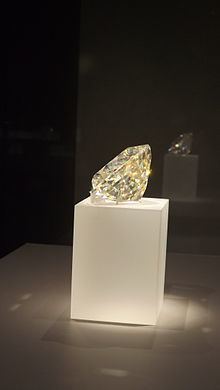 | ||
The Light of the Desert is a cerussite gem in the Royal Ontario Museum's collection. It is the world’s largest faceted example of cerussite, weighing 898 carats (6.3 ounces). The word “cerussite” comes from the Latin meaning “white lead”; the mineral is a lead carbonate with the chemical formula of PbCO3. The raw cerussite was discovered in Tsumeb in northern Namibia and acquired by a gem cutter from Arizona who then cut the raw material into the gem on display. The cutting and transport of this gem is a delicate business as cerussite is extremely fragile and sensitive to changes in temperature changes and vibration. After it was cut in Arizona, the gem was placed in a box, then wrapped in a large woolen scarf and a winter vest, and then hand transported to Toronto for display. Cerussite is too fragile to ever be set in jewelry.
Cerussite is known for its dispersion (or fire). Dispersion is the amount of light a gem will pass through the colour spectrum. Many gem collectors view cerussite favourably because of its ability to clearly prism light into the different colours of the light spectrum.
